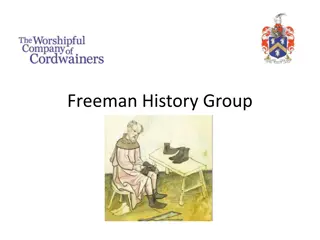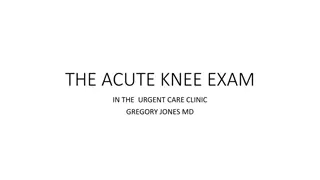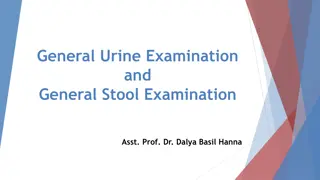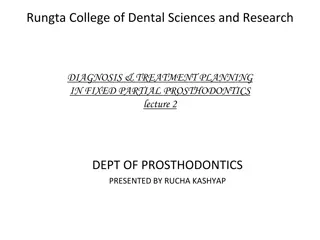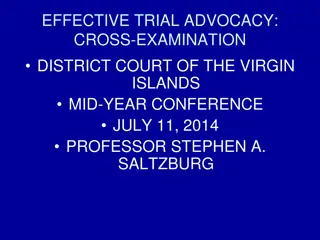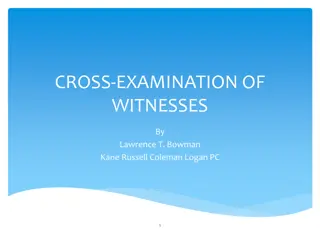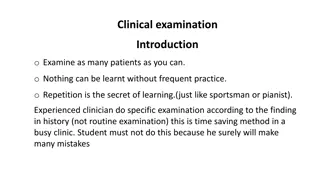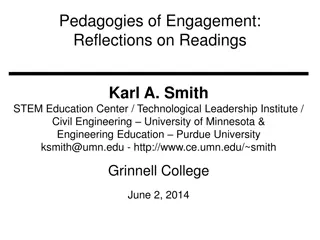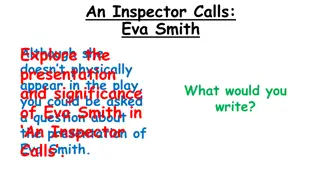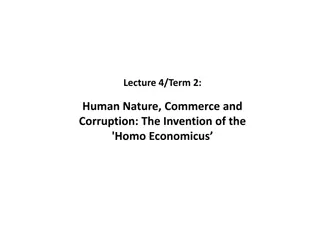Examination of Processus in Salisbury: Dolling v. Smith (1271-1272)
Delve into the historical case of Dolling v. Smith in Salisbury, exploring the intricate legal process, appeals to the archbishop of Canterbury, and the complexities of medieval marital disputes. Follow the journey of Alice Dolling as she seeks to establish her marriage to William Smith amidst conflicting testimonies and jurisdictional challenges.
Download Presentation

Please find below an Image/Link to download the presentation.
The content on the website is provided AS IS for your information and personal use only. It may not be sold, licensed, or shared on other websites without obtaining consent from the author. Download presentation by click this link. If you encounter any issues during the download, it is possible that the publisher has removed the file from their server.
E N D
Presentation Transcript
Continental European Constitutional and Legal History: William Smith c. Alice Dolling (1271 1272) Lecture 10 Click here for a printed outline.
Introduction The role of cases in Continental European legal systems Some comparative remarks. The presence of case records in the medieval and early modern periods.
The processus in Salisbury in Dolling c Smith Smith c Dolling. The principal record in this case is what is known as a processus, the entire record of a case before a particular court. It was made up when the defendant in the original case, Smith, appealed from the consistory court of the bishop of Salisbury to the provincial appellate court of the archbishop of Canterbury. So the processus is a processus in a case that would be called Dolling c. Smith. The archbishop of Canterbury had jurisdiction to hear appeals from the Southern Province in England, 14 dioceses in England proper and 4 in Wales.
The processus in Salisbury in Dolling c Smith(contd) Normally, the appellate court would sit in London, but because the see of Canterbury was vacant (the archbishop having died and a new one not yet appointed), the court sat in Canterbury, because the prior and chapter of Canterbury cathedral exercised vacancy jurisdiction. The record is today in the Cathedral Archives and Library at Canterbury. Here s what happened in the court from which the appeal was taken, the consistory court of the bishop of Salisbury. 10 July 1271 Alice Dolling appeared in the consistory court of Salisbury claiming that William Smith was her husband. William denied the charge, and Alice was told to produce her witnesses before the dean of Amesbury. A.D. 1271, Friday after the feast of the translation of St. Thomas, martyr [10 July], Alice of Winterbourne Stoke appeared against William Smith saying against him that he contracted marriage with her, wherefore she asked that he be adjudged her husband by sentence; she says this, etc. [not committing herself to proving each and every element in her libel but insofar as she proves so far may she obtain]. The man, joining issue, denies the contract; the parties sworn to tell the truth say the same thing as before. The reception and examination of witnesses is committed to the dean of Amesbury. .
The processus in Salisbury in Dolling c Smith(contd) The record is written in Latin. Alice could have hired a proctor to represent her in the court, but if she had the record would have said that she did. Alice did not know Latin, nor did she know the formula that we used to fill in the etc. in the record: not committing herself to proving each and every element in her libel but insofar as she proves so far may she obtain. Alice probably appeared in court and made her complaint in Middle English. There is a substantial filter between Alice s voice and what we read here. The record of the first entry tells us that William denied the charge, and that Alice was told to produce her witnesses before the dean of Amesbury. Below the level of the diocese there are archdeaconries. Within each archdeaconry in most places parishes are arranged into deaneries.
The processus in Salisbury in Dolling c Smith(contd) 30 July 1271 Alice asked for and obtained a second production of witnesses. Thursday next after the feast of St. Peter in chains [30 July], the parties appeared personally and the woman asked for a second production and got it. 23 September 1271 The depositions of Alice s three witnesses were published in open court. Wednesday next after the feast of St. Matthew the apostle [23 September], the parties appeared personally; the woman renounced further production; the attestations were published with the consent of the parties; the parties were given a copy; a day was given for sentencing if it was clear. The woman constituted her brother Roger her proctor in the acts to hear the definitive sentence.
The processus in Salisbury in Dolling c Smith(contd) Monday next after the feast of the apostles Simon and Jude [26 October], the parties appeared personally; the man under interrogation confessed in court that he had carnal knowledge of the said Alice a half a year ago. The same man proposed an exception in the following form: Before you, sir judge, I, William of Winterbourne Stoke, peremptorily excepting propose against the witnesses of Alice Dolling that they depose falsely because from the ninth hour of the day on which her witnesses depose that I contracted marriage with her until the first hour of the subsequent day I was continuously at Bulford, so that it would have been impossible for me at the hour about which the witnesses depose to have contracted marriage at Winterbourne Stoke. And this I offer to prove. The reception of the witnesses produced by the man on his exception and their examination is committed to the dean of Amesbury.
The processus in Salisbury in Dolling c Smith(contd) 26 October 1271 William confessed that he had had intercourse with Alice six months previously but denied that they had contracted marriage, claiming that he had been in Bulford on the St. Stephen s day [26 December] almost three years previously, the day on which Alice alleged that they exchanged the words of marital consent in Winterbourne Stoke. (Technically, this was an exception against Alice s witnesses, an allegation that they had perjured themselves.) The dean of Amesbury was to examine William s witnesses.
The processus in Salisbury in Dolling c Smith(contd) 18 November 1271 Alice answered William s exception with a replication that alleged that William had indeed been in Winterbourne Stoke on 26 December 1268. The rectors Berwick and Orcheston were to examine Alice s witnesses. Wednesday next before the feast of St. Edmund, king and martyr [18 November], the parties appeared personally; the woman made a replication of presence; let the woman produce her witnesses before the rectors of Berwick and Orcheston, however many she wishes to produce before the next consistory; let the man also produce however many witnesses he wishes to produce about his absence before the said dean and the chaplain of Amesbury before the next consistory. 15 December 1271 The depositions of William s ten witnesses on his absence and Alice s four witnesses on his presence were published in open court.
The processus in Salisbury in Dolling c Smith(contd) Tuesday after the feast of St. Lucy the virgin [15 December, 1271], the parties appeared personally; the woman excepting proposed that it was not her fault that her witnesses had not been examined and asked that they be admitted in court; they were sworn, their examination committed to the dean of Amesbury and Richard de Rodbourne, and the way of further production precluded for her. On the same day [this may not be right] the attestations both on absence and presence were published with the consent of the parties; copies of the attestations were offered to and obtained by the parties, and a day was given for doing what law shall dictate. 27 January 1271/2 After some dispute a day was given for sentencing. Wednesday next after the octave of St. Hilary [27 January, 1271/2], the parties appeared personally, and when there had been some dispute among the parties about the attestations of the parties, a day was given for sentencing if it was clear.
The processus in Salisbury in Dolling c Smith(contd) 11 February 1271/2 William was ordered to produce his witnesses again so that the court might inquire more fully into the continuity of his absence. The day after St. Scholastica the virgin [11 February, 1271/2] the parties appeared personally. It was decreed that the aforesaid W. produce in the next consistory all his witnesses whom he had previously produced on his exception so that it might be inquired more fully about the continuity of absence. 1 5 March, 1271/2 William alleged that he could not produce his witnesses again because some of them had died and some of them had left the province for a pilgrimage and for other necessary cause. The parties once more disputed about the process, and a day was once more given for sentence. [The Salisbury processus inserts the depositions of the witnesses at this point.]
The processus in Salisbury in Dolling c Smith(contd) Tuesday after the feast of St. Mathias the apostle, continued until Wednesday, Thursday, Friday, Saturday next following [1 5 March, 1271/2], the parties appeared personally. The same man alleged that he could not produce his witnesses before us because some of them did not exist in the nature of things and some of them had left the province for a pilgrimage and for other necessary cause. And when the parties had disputed for a while about the processus, the same William demanded that a copy of the entire processus be made for him, which decreed and obtained, a day was given for doing what law shall dictate in the next consistory after Easter. 11 May 1272 The official of Salisbury rendered sentence for Alice declaring that William was her lawful husband. [A later document in the case tells us that William immediately appealed to the Court of Canterbury.]
The processus in Salisbury in Dolling c Smith(contd) Wednesday after Misericordia Sunday [11 May], A.D. 1272, the parties appeared personally and concluding the case asked that sentence be given. We the official of Salisbury proceeded to definitive sentence in this way: In the name of the Father, amen. We the official of Salisbury having examined the merits of the aforesaid cause and having gone over the acts of court carefully, because we find the claim of the said Alice sufficiently proven, notwithstanding the exception proposed on the part of William, which is not proved clearly in its form, as it ought to be, adjudge William by sentence and definitively to be husband to the same Alice.
Proceedings on appeal to the Court of Canterbury (contd) 3 June 1272 The record of the hearing on this day does not survive, but is described in the examiners report. Alice did not appear. The court pronounced in favour of its jurisdiction in the appeal. 26 July 1272 William probably appeared in the Court of Canterbury on this day (the record does not survive but is referred to in a subsequent record. Alice, we learn from the examiners report did not appear. Between 26 July and 30 September (undated) Alice did not appear. William Smith and his proctor William Attehide of Writhlington appeared and were given the next court day after Michaelmas [29 September] to proceed with the case according to the acta of 26 July, 1272. 30 September prorogued to 4 October 1272 Alice did not appear. William proposed exceptions to the processus before the official of Salisbury. The judge (unnamed) ordered the examiners of the court to examine the processus and report back to him about it at the end of October. The report has survived and is given on the outline in full. 29 31 October 1272 Once more Alice did not appear, although she had been cited by the official of Salisbury. The commissary of the official of the Court of Canterbury reversed the decision of the official of Salisbury. The sentence is given on the outline in full.
Some remarks on the processus This is the ordo judiciarius as Tancred defines it. It also seems to be quite efficient. The case was begun in July of 1271; final judgment om the lower court was rendered in May 1272. The defendant, who lost in the original court, appealed, and the appellate court reversed the judgment of the Salisbury court in October of 1272. Trial and appeal took a little more than a year. There are very few court systems in the U.S. that could do as well today. The pattern of claim, exception, and replication, with proof taken on each one separately, that we see in the processus in the Salisbury court is probably the product of the Romano-canonical rule that one cannot introduce testimony directly contradicting testimony that has already been published. The problem is that with a complaint as vague as this one He contracted marriage with me the defendant has no idea what he is supposed to get testimony about. The solution to the problem, at least in the English church courts, was to allow the defendant, after the plaintiff had introduced his or her proof and it had been published, to frame his or her defense in the form of exceptions to the plaintiff s witnesses. The defendant says that plaintiff s witnesses are not to be believed, because they are liars.
Some remarks on the processus(contd) This pattern of claim with proof taken on it, then another claim and proof taken on it is characteristic not only of medieval Romano-canonical it is also characteristic of Continental procedure today. The reason for it is clear. There s no trial in this form of procedure, as we understand a trial, a single occasion on which all the proof is presented, because there s no jury and the judge is sitting full-time. This means, particularly in civil cases, that the court and the parties can identify key issues that may determine the case and present proof about them without ever having to present all the proof they have. Some people think that this may be a more efficient way of doing things. In the spring of 1272, the official of Salisbury asked William to produce his witnesses again so that he, the official, could inquire about the continuity of William s absence. William returns and says he cannot produce his witnesses again because: some of them did not exist in the nature of things [i.e., they were dead] and some of them had left the province for a pilgrimage and for other necessary cause. You can believe that if want to; I don t.
The depositions in the Salisbury court In Alice s first set of depositions there were three witnesses: Celia daughter of Richard Long, Margaret sister of Celia, and Margaret daughter of Michael. William produced ten witnesses in support of his exception of absence five of whose depositions are included on the outline: John Chaplain, Richard Sturre, Hugh Meriot, Peter son of Alice, Roger de Cowland; and five of whose depositions are not: Walter de Ponte, John le Devenes, John Sirie, Hugh Baghe, and John son of the weaver. There are four witnesses on Alice s replication of presence: Edith of Winterbourne Stoke, Edith Dolling, sister of Alice Dolling, Agnes Grey and Alice daughter of William Chaplain. There are many depositions that survive from medieval English marriage cases. I can t recall any where the witnesses divide along gender lines quite so dramatically as do the witnesses in this case.
The depositions in the Salisbury court (contd) In Alice s first production, Celia daughter of Richard Long testified that on December 26 two years previously she was present in the house of one John le Ankere in Winterbourne Stoke at nightfall, in front of the bed that she and Alice shared. William and Alice were sitting, probably on a bench in front of the bed. He was dressed in a black tunic of Irish homespun with an overtunic and hood of russet; she was dressed in a white tunic with a blue hood and wore shoes with laces. William took her by the hand and said: I William will have thee Alice as wife so long as we both shall live and to this I pledge my troth. Alice replied: And I Alice will have thee as husband and to this I pledge thee my troth. Asked why William had come there, she said to have carnal knowledge of Alice if he could. Asked if she had ever seen them having intercourse, she said no, but she did see them lying together naked in the same bed. Margaret calls herself the sister of Celia daughter of Richard Long. Her testimony basically agrees with Celia s, though she says that William s tunic, overtunic and hood were all gray. She never saw them lying together.
The depositions in the Salisbury court (contd) Margaret daughter of Michael has a slightly different version of the words exchanged: William said: I William take thee Alice as my wife if holy church allow it, and to this I pledge thee my troth. She said: I Alice will have thee as husband and will hold thee as husband. William s ten male exception witnesses tell a different story: William was in Bulford, four miles away, on St. Stephen s day two years previously. They give a vivid description of an all-day ale-feast, held by the parish guild. William was serving at the feast and could not possibly have been in Winterbourne that day. Alice s four female replication witnesses say that they saw William in Winterbourne that day, where he is described as leading around a crowd of women or going hand-in-hand with a woman.
What was going on in this case? Someone was lying. Two of Alice s witnesses on the principal case seem to have been related to her: they were probably her half-sisters. One of Alice s replication witnesses may have been her full sister. The witnesses on the principal case are not completely clear about what words were exchanged: two of them seem to testify to verba de futuro, one of them to verba de presenti but the tense of the verbs should make no difference when intercourse is conceded. The replication witnesses do not seem to be talking about the same day as the first two sets of witnesses are, though this may be the result of scribal error in the depositions or a truncation of what actually happened in the processus rather than any confusion on the witnesses part.
What was going on in this case? None of these observations is new. They are all made in a remarkable document that survives from the case on appeal. The judge of the provincial court of Canterbury asked the examiners of the court to look at the processus below and evaluate it for him. They committed their evaluation to parchment, and it is quoted in full on the outline. In the end the examiners suggest that there are too many inconsistencies in Alice s basic story, that her witnesses on her principal claim are suspect because they are related to her, that the witnesses on William s exception tell a convincing story, that Alice s replication witnesses may not even be talking about the same day, and, besides, ten witnesses are better than four. The judge of the provincial court seems to have agreed; he reversed the official of Salisbury s decision. This is quite in conformance with Tancred s advice about evaluating witnesses.
Some social history that may help Names. Surnames are unstable in this period, and not everyone in this class of people had them. Alice does, and this suggests that she was of somewhat higher status than were the very poor. Her surname, Dolling , is of unmistakably Anglo-Saxon origin. William s surname, Smith , is a trade name. We can t even be sure that it is a surname. He may be William, the smith. His witness, who says that his mother is the same as William s mother, calls himself Hugh Meriot. That is also, probably, a name of Anglo-Saxon origin. The prefix of John le Ankere s surname suggests that the name is French, as indeed it is. The name is not found in England until after the Conquest.
Some social history that may help (contd) There is a northwest European marriage pattern . First marriages tended to be relatively late, the women being in their late teens or early twenties, and the men not much older. From puberty to this relatively late marriage both men and women were not supposed to get married and, particularly the women, were supposed not to have sexual intercourse. During the awkward period between puberty and marriage, parents shipped out their children to serve as servants or apprentices for others. This is sometimes called life-cycle servanthood . The women and men who worked as servants were able to save some money. They used this money to get married. It is tempting to think that Alice and her half-sister, Celia daughter of Richard Long, were this kind of servant in the house of John le Ankere in 1268. There were relatively few trades that were open to women in medieval England, but brewing ale was one that was. That seems to have been what William s mother, Alice, was doing in Bulford in 1268.
The bottom line Can we draw any social conclusions from such cases? Most liars cannot make things up out of nothing. One hundred years after Alexander s decisions news of them had reached Winterbourne Stoke. Can we ever be sure that the witnesses are telling anything like what really happened? Can we say anything about what happened in Winterbourne Stoke? The cases give us some evidence that we can use to tell a story that might otherwise not be told: People did seem to know what the rules were. Because people knew what the rules were, they knew what they had to say in order to achieve the desired result in court. What causes the courts sometimes to accept the results that the parties and witnesses are urging them to accept and sometimes to reject them is a complicated question, the answer to which is highly problematic.
The bottom line (contd) As the late Michael Sheehan noted, the attitudes toward marriage reflected in the court records are extraordinarily individualistic. This individualism, however, has limits. What does all this have to do with Alexander III and his decisions?


